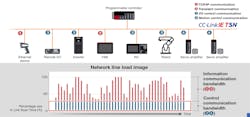We are seeing Ethernet become the communications backbone in virtually every industry, and for good reasons:
- Speed and bandwidth: Ethernet provides high-speed communication with bandwidths of up to 10 Gbps, allowing for fast and reliable communication between devices.
- Interoperability: Ethernet is an open standard, which means that devices from different manufacturers can communicate with each other seamlessly. This allows for greater flexibility and interoperability in industrial automation systems.
- Scalability: Ethernet is easily scalable, allowing for the addition of new devices and components to an industrial automation system without the need for major upgrades.
- Cost-effectiveness: Ethernet technology has become more affordable, making it a cost-effective solution for industrial automation applications.
- Industry support: Ethernet is widely adopted and supported by industry standards organizations, such as the Institute of Electrical and Electronics Engineers (IEEE), making it a reliable and trusted technology.
- The Ethernet specifications have continued to evolve and are now offering the next generation of capabilities for the industrial automation marketplace to adopt. The releases of these features, referred to as Time Sensitive Networking (TSN) take Ethernet to a new level of performance, specifically in the area of timing and determinism.
- 2006 - IEEE 802.1AS: This standard specifies timing and synchronization for time-sensitive applications in Ethernet networks, enabling precise time coordination between devices. Each device on the network will have an extremely accurate clock to enable message coordination and information timestamping.
- 2010 - IEEE 802.1Qav: This standard introduces the concept of time-aware shaping, which allows network switches to prioritize traffic based on the timing requirements of the application.
- 2012 - IEEE 802.1Qbv: This standard defines a time-based scheduling mechanism that enables the deterministic transmission of time-sensitive traffic in Ethernet networks.
- 2014 - IEEE 802.1Qbu: This standard introduces frame preemption, which allows high-priority frames to interrupt the transmission of lower-priority frames to ensure timely delivery of critical traffic.
Prior to these additions, Ethernet communications relied on best effort communications. In Ethernet, best effort communication is the default mode of operation. Ethernet networks are designed to operate in a shared media environment, where multiple devices compete for access to the network. As a result, there is no inherent priority given to any device or type of traffic. All data is treated equally and transmitted as quickly as possible. This meant that communications that required determinism needed to be isolated from communications that could impact that determinism. Hence, Operational Technology (OT) must be isolated from Information Technology (IT) networks.
Standards bodies assist with TSN vendor adoption
The work to deliver Ethernet with TSN is complete, and there are several organizations working to adopt and promote the standards for different purposes:
- IEEE (Institute of Electrical and Electronics Engineers) - IEEE is the primary standards organization for TSN, and its 802.1 working group is responsible for developing the TSN standards.
- IEC (International Electrotechnical Commission) - IEC is a global standards organization that collaborates with IEEE in developing TSN standards.
- Avnu Alliance - Avnu Alliance is a consortium of companies that promotes TSN technology and certifies TSN-compliant products.
- OPC Foundation - OPC Foundation is a nonprofit organization that develops and maintains standards for industrial automation and related domains. It has been working on integrating TSN with its OPC UA (Unified Architecture) standard.
- TIACC – TSN Industrial Automation Conformance Collaboration is a collaboration between Avnu Alliance, CC-Link Partner Association, ODVA, OPC Foundation, and PROFIBUS & PROFINET International to develop a single common conformance test plan for the IEC/IEEE 60802 profile of TSN for Industrial Automation.
- CC-Link Partner Association – CC-Link IE TSN is the first industrial automation network to leverage TSN and the CLPA is the first organization to license and deliver compliant products for end user selection and configuration.
- SAE International - SAE International is a professional association for engineers in the aerospace, automotive, and commercial vehicle industries. It has been involved in developing TSN standards for automotive applications.
The advantages of using TSN in your enterprise
With the availability of TSN, users can now benefit from full access to all devices on their network, from an IT perspective, for both monitoring and management. The introduction of TSN-enabled network switches can ensure the prioritization of control communications within new machines or processes. These new switches intelligently isolate control communications to “Islands of TSN” for the purposes of advanced control, while also enabling access to all devices for data collection and configuration.
In Process Control, industrial processes such as chemical and petrochemical plants, precise timing and coordination can be crucial to ensure the safety and reliability of systems. Ethernet TSN can help ensure timely delivery of critical data and commands, minimizing the risk of errors and improving overall system performance.
In Power and Utilities, TSN can be used to improve the performance and efficiency of smart grid and substation systems by enabling real-time communication and coordination between various components, such as power generators, transformers, and energy storage systems.
We are seeing more and more applications that require precise control of temperature, pressure, flow, and other parameters to ensure consistent and reliable operation. TSN can enable real-time communication between process control devices such as sensors, actuators, and controllers, ensuring that process parameters are monitored and adjusted in real-time.
What will TSN adoption look like?
The adoption of TSN isn’t an all or nothing scenario. You should expect to see TSN as an integral part of new equipment, delivered by OEMs or System Integrators, leveraging the improved performance for internal operations, but also delivering a more open solution that can assist with your walk toward a Digital Transformation.
Ethernet with TSN will benefit Digital Transformation processes in several ways.
- Improving network reliability: TSN can provide a more reliable network infrastructure by prioritizing time-sensitive traffic and preventing congestion. This can help ensure that critical data is transmitted without delay, no longer just relying on best effort communications.
- Supporting interoperability: TSN is designed to be an open standard that can be implemented by different vendors. This can help support interoperability between different devices and systems, which is critical for digital transformation. TSN-based products are on the market today and systems are built through the selection and configuration of components, not the fundamental development of technology.
- By providing greater access to data, TSN enables more effective data analytics and insights. TSN can help organizations collect and analyze real-time data from a wide range of sources, including sensors, control systems, and other devices. This data can then be used to optimize operations, improve product quality, and enhance overall business performance.
Overall, TSN provides greater access to data for digital transformation by integrating IT and OT networks, enabling more efficient and reliable communication between devices, facilitating the collection and analysis of real-time data, and enabling organizations to optimize their operations and improve their overall business performance.
If you're interested in learning more about TSN, here are some resources that can help:
IEEE Standards Association: The IEEE is the organization that developed TSN, so their website is a great place to start. You can find the TSN standards themselves, as well as whitepapers, tutorials, and other resources related to TSN.
Research papers: There are many academic papers that have been written about TSN, so if you're interested in a more technical or in-depth understanding of TSN, these papers can be a good resource. Some places to search for papers include IEEE Xplore, ACM Digital Library, and Google Scholar.
Books: There are also several books available on TSN, which can provide a more comprehensive understanding of the subject.
Web resources for TSN: Industrial Internet Consortium: The Industrial Internet Consortium (IIC) is a non-profit organization dedicated to promoting the adoption of the Industrial Internet of Things (IIoT). Their website contains a wealth of information about IIoT, including Ethernet TSN.
LinkedIn: LinkedIn is a social networking site for professionals, and there are several groups dedicated to Ethernet TSN. Joining these groups can provide you with access to industry experts and discussions about the latest developments in Ethernet TSN.
YouTube: There are numerous YouTube videos dedicated to Ethernet TSN.
Roy Kok is a senior partner and alliance specialist for Mitsubishi Electric’s e-F@ctory Alliance.



